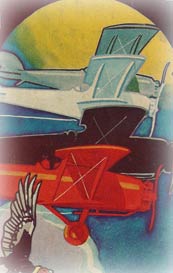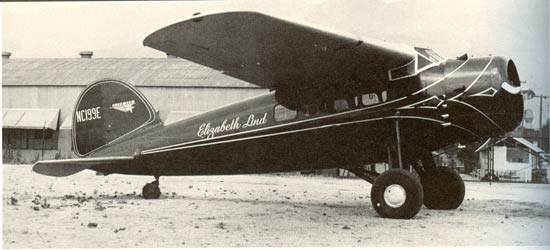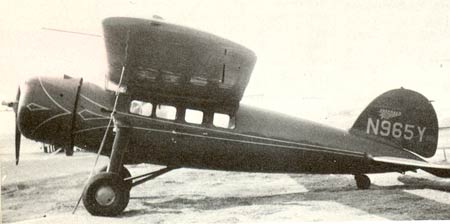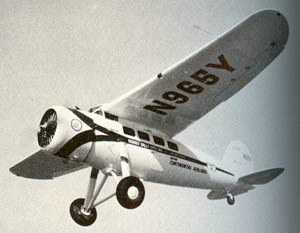|
Registration Number NC199E
From Viking to Movie Star to Museum
Piece
This airplane is a Lockheed Vega 1, S/N 40 (ATC 49) manufactured
on January 20, 1929 by Lockheed Aircraft Corporation, Burbank, CA.
It came with a Wright Whirlwind J5A engine (S/N 9347) of 200-220HP.
It was a five-place aircraft. It carried two names at different
times: “The Viking” and “Elizabeth Lind”.
Some photos from the Allen reference, left.
It was sold on May 12, 1930 to Montana Development & Air Transport
Co., Inc. of Kalispell, MT, and repossessed by Lockheed on
March 16, 1931 (hard times early in the Great Depression?).
We have a small window into its life about a month before it was repossessed. Site visitor Shari Brown shares the image below of her Great-Grandfather's pilot log book. She says , "Here is a scan of the Feb 8, 1931 page showing the NC199E. [Her Great-Grandfather] William Hoffman [not a Register pilot], flew this plane on Feb 8, 1931. He was based out of Oakland, California and his log book shows two entries for this plane on Feb 8, 1931. One line shows '10 landings each to a full stop' and the next line shows 18 flights with the note 'passenger and pleasure trips.' He flew it for a total of 3 hours and 40 minutes. It does not say where the trips were to or from, unfortunately, but it's my guess it was out of Oakland." The airplane's life was soon to become more exciting.
Pilot Log Entry, NC199E, February 8, 1931 (Source: Brown)
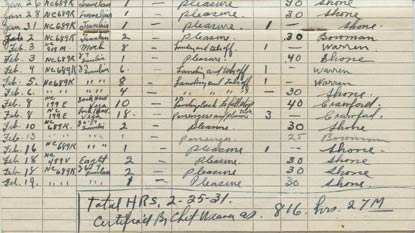 |
A few months later, on June 19, 1931, NC199E sold (less engine) to the MacMillan Arctic
Exploration Co., Ltd. of Los Angeles. It was remodeled as
a “Vega Special” as a two-place airplane, with
Pratt & Whitney Wasp engine and an “NR”, restricted,
registration (see this link for what the “N” numbers
mean).
It was mounted on floats and taken on an air survey and photo
expedition to Labrador and Greenland led by Commander Donald
B. MacMillan. It was painted white, and named “The Viking”. Below, courtesy of Tim Kalina, an image of the airplane as owned and operated by MacMillan. Mr. Kalina says about the image, "This is a small, original photo of NR199E, the ‘Viking’. You can see this name on the cowl of the Vega. I have also included a scan of the back of the photo as the writing is interesting. The location is Rockland, Maine and I believe MacMillian made the arctic photography flight in 1931. Note that the wing and tail surfaces are a darker color, most likely some shade of orange, perhaps the much used International Orange." Another photograph of NR199E is at the link.
Lockheed Vega NC199E In Maine, 1931
(Source: Kalina)
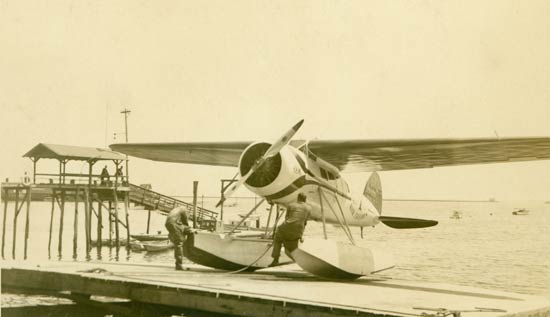 |
Lockheed Vega NC199E In Maine, 1931, Caption
(Source: Kalina)
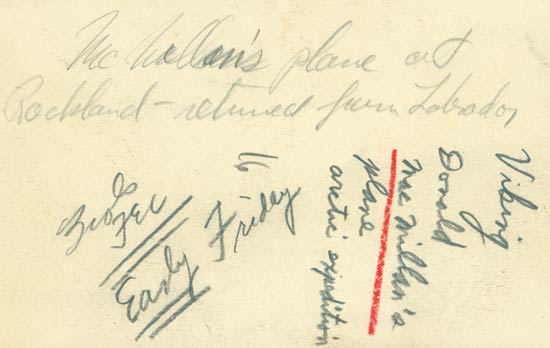 |
On November 16, 1932 NR199E sold to Paul S. Grade of Los Angeles,
CA and converted to a Vega 2D, four-place model with “NC”
license. Grade bought it less engine, and installed a P&W
Wasp Jr. of 300HP.
It went through four more California owners over the next
two years. It sold on June 7, 1934 to George
Thomas Westinghouse, Rt. 2, Box 464, Tucson, AZ. While
in his custody, NC199E was painted blue-gray and was named
“Elizabeth Lind”. It was flown on both wheels
and floats, as Westinghouse flew it off the water from his
home near Seattle. The airplane was purchased expressly so
that Westinghouse could commute between Tucson, Victoria,
Seattle, Vancouver, B.C., and other places.
Westinghouse and “Elizabeth Lind” landed at Tucson
three times, on December 25, 1934, February 16, 1936 and April
6, 1936. The photo, below, is of the aircraft on wheels.
Originally, I asked site visitors to look closely at the
background. Does anyone know where this image was taken? This
helpful note from George Thomas' son (left sidebar) clarifies the location:
| "The building behind NC199E on the website is the
Lockheed plant in Burbank. Dad had the aircraft repaired
and painted there in 1935. We don't know who Elizabeth
Lind was - or we have forgotten. Dad died in 1983 and
all of his brothers and sisters who might know have all
passed away. The Vega remained in the family until 1954." |
Its history over the next nineteen years is uncertain from
the NASM records, but, again, George Thomas' son clarifies:
| "In 1940 my father transfered the title
to his brother, Aubrey, and they disassembled it and put
it in storage at Bekins in Seattle. My father then went
off to Britain via Bermuda and a "Canso" to
join the RAF. While in storage, the Vega wing was hung
on a wall. A truck backed into it and crushed the center
section. After the war there was much argbargy [sic] with
Bekins- finally they relented, as Dad was using up a lot
storage space at pre-war rates. The aircraft was moved
to Lana Kurtzer's new hanger on Lake Union, repaired,
and reassembled by Ted Albright, at Bekins' expense. The
3/32" top wing skin was removed, the ribs repaired,
and the skin thickness was increased to 1/8' 3 ply spruce,
for seaplane service." |
According to NASM records, on July 27, 1953 the airplane
was sold to Lana Robert Kurtzer of Seattle. Below, shared by Tim Kalina, is a view of the airplane on floats in Seattle.
Lockheed Vega NC199E in Seattle, Ca. 1950s (Source:The David Horn Collection via Kalina)
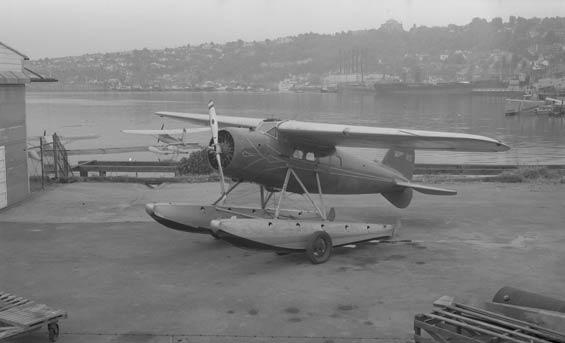 |
Mr. Kalina says about this photograph, "My friends in Seattle tell me the location is Lana Kurtzer's seaplane ramp on South Lake Union. They also tell me that Kurtzer may not have owned the plane at this time as he almost always painted his last name on his planes floats. So ... I'd say this photo was taken when George Thomas still owned the Vega and just after it had been repaired/overhauled and fitted with floats. Across the lake, in the background, you can see the old Seattle Light steam power plant, which still stands today. Now it is commercial space and the original 7 smoke stacked have been removed and replaced by six shortened ones, which help to improve the lake view for the homes above and behind the old power plant. I have attached a Google Earth screen grab which shows the approximate location of the Vega and the power plant across the lake." The Google Earth view is below.
View of South Lake Union With Seattle Light Steam Power Plant Outlined in Red (Source: Kalina)
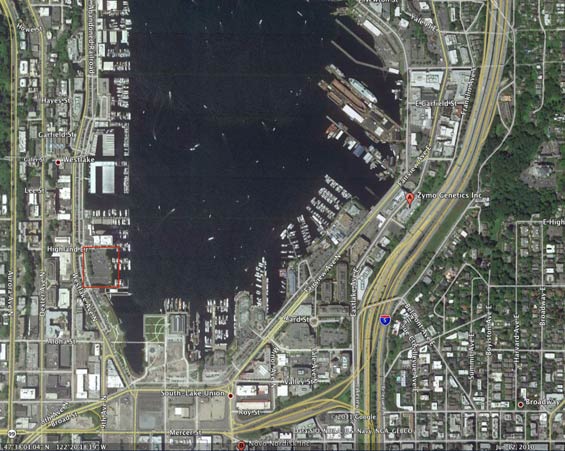 |
Kurtzer kept 199E for
three years and sold it, in turn, to Paul Mantz Air Services
of Santa Ana, CA on July 28, 1956. There it was used in movie
work and for static display at the Mantz hangars. For the
next decade, it was the oldest Vega still flying. George Thomas'
son reports on the airplane during this period:
| "It was chartered out of Anchorage for two summers,
when Kurtzer sold it to Paul Mantz of Santa Ana, CA. Sitting
outside in the rain for 18 months caused a lot of dry rot
in the center section and it would not pass its annual
anymore. It was flown down to California on a "ferry
permit" in the summer of 1956. When Paul Mantz was
killed, making "The Flight of the Phoenix" in
1967, TallMantz, Inc. was dissolved and all the aircraft
were dispersed all over. The Vega, going to Dearborn.
The Vega sits today exactly as received, oil streaks and
leaks and all." |
The NASM record and Allen's book, left column, pick up the
story in 1962. In anticipation for its use in a film about
Amelia Earhart, Mantz reregistered it as N965Y, Amelia’s
old number. Photo, below, shows it in that livery.
Later, in 1964, the paint and trim were changed to the red
and white livery of Varney Air Transport, the ancestor of
today’s Continental Airlines (photo below). In that
paint scheme it went on a national publicity tour.
Although it is no longer flying, it maintains the Varney
paint, and is on exhibit at the Ford Museum in Dearborn, MI,
which acquired it in 1968. See a picture of it now at this
link.
---o0o---
THIS PAGE UPLOADED: 12/30/05 REVISED: 01/21/06 09/26/07, 12/05/08, 02/15/11, 01/02/13, 06/14/15
|

